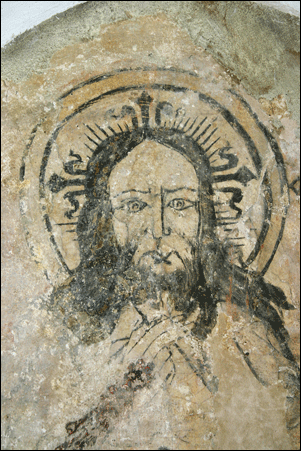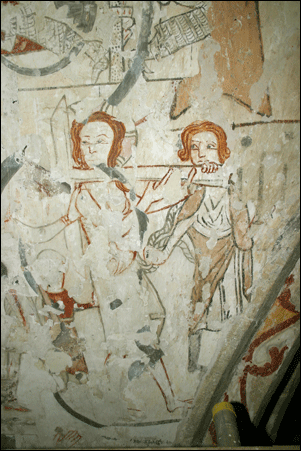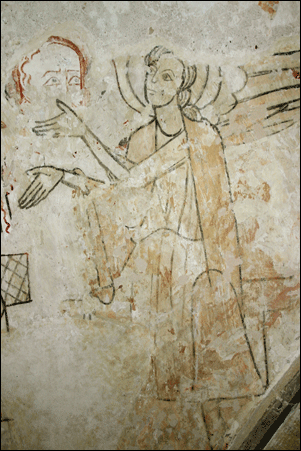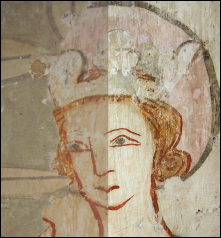
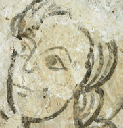

The following section is taken from the full Conservation Record prepared by the Perry Lithgow Partnership in September 2009. It deals with the principle discoveries and observations made during the conservation work. The report refers to piers by reference number (N1, N2, etc). These references were simply applied to each pier in the arcades. N1 therefore refers to the North arcade, and the first pier from the East - with the second from the east being N2. The large central pier, that faces the south doorway, and formed a focus for many of the later schemes, was referred to as N3.
The angel on N3 marks the end of Scheme 1 and therefore provides a date at which the nave was extended westwards, currently thought to be c.1250. Spandrels N4 and N5 have only the second decorative scheme.
There is no evidence of the spandrels N1 & N2 having been decorated with Scheme 2, although traces of the second scheme do survive in the arch mouldings and soffits. Only fragments of Scheme 3 are visible in these spandrels. The closeness of the dates for Schemes 1&2 suggests that the first scheme may have been retained and incorporated into the second decorative scheme.
N4
A series of stars were revealed during work, as an embellishment to the very crudely painted roundels. There is also a single trefoil motif in the centre.
N3
The Passion cycle is out of sequence, with the Crucifixion appearing before the Flagellation and Carrying of the Cross. This is presumably due to the available wall space.
The top tier of scenes appear within arches with columns and capitals separating each scene (although there is some overlapping). The middle tier has no formal separation device.
A fourth, previously unidentified scene was discovered in the top tier: small traces of a figure were discovered, presumably indicating a scene depicting Noli Me Tangere.
There is a crowned figure in the Harrowing of Hell, between Adam (very fragmentary) and Christ. This is extremely unusual. There is some resemblance to the figure of St Edmund lower down on this pier, although the figure currently remains unidentified.
Removal of covering limewash revealed much more detail of the two soldiers at the tomb – the sword, their armour and the architectural surround of their scene, including trefoils and drops of blood on the pillar and capital. In addition, the red ground was embellished with white dots, while the white architectural features had black dots.
In the lower area of N3, the presence of a large Virgin and Child was confirmed. This had previously been tentatively identified by David Park during a survey in 1998.
Arches and soffits
It had been previously suggested that the black scrollwork pattern dated from the Second Scheme. Treatment has confirmed that this in fact is from Scheme 1, as traces of Schemes 2 & 3 are visible on top. Cleaning and uncovering has revealed a series of stars in the soffit of N2/3 and a section of trompe l’oeil marbling above the capital of N1, both of which belong to Scheme 2.
Saints
Two large figures in spandrels N1 & N2 and dating from Scheme 3 were revealed more clearly during treatment. In N2 the figure appears to be St Paul as he is shown holding a sword (comparable in style to the sword held by the soldier in The Passion Series). The figure in N1 is holding what may be a key, in which case he would be St Peter, although this is a very tentative identification, as the damage is extensive. There is enough room in each spandrel for further figures, although of the several fragments remaining, only a small section of hair on the earlier angel’s face in N1 is identifiable.
The presence of a figure on the west facing side of the N2 pier was confirmed during treatment. In addition, a previously unknown third figure was identified on the north face of the same pier, although this is extremely faint. The identity of these four figures (in total) is unknown but it is presumed that they are saints or perhaps donors/patrons.
North Aisle, north-east corner
The fragment of painting to the east of the window can, after treatment, be seen to include a series of small rosettes set within what appears to be a black diaper pattern, embellished with trefoils. It is still unclear whether this is purely decorative or part of some elaborate drapery related to a now-lost scheme at the east end.
